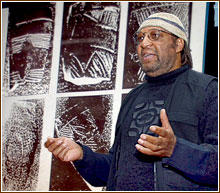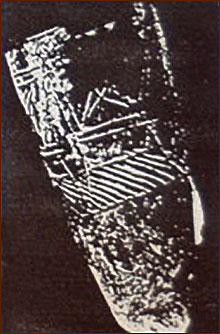BLACK HISTORY BY THE SHOVEL FULL
Artist-Archaeologist Shines New Light on Slave Life
By Hoag Levins
 | |
 February 11, 2002
February 11, 2002
CAMDEN -- Those interested in understanding the daily lives of slaves are likely to learn more by shoveling dirt than reading through the written records of America's

Photo: Hoag Levins
|
Joe L. Speight and images of eighteenth-century slave-pipe decorations. Larger photo.
| plantations, Joe L. Speight told an audience at the Camden County Historical Society (CCHS) yesterday.
Appearing as both guest curator of "The African American Experience" art show and an archaeologist who has excavated and studied slave site artifacts, the Marlton resident spoke on "Art, Archaeology and the Black Experience."
The talk in CCHS's Boyer Auditorium capped the day-long art-show reception in adjacent Pomona Hall Gallery where works of 18 artists are on display.
Slave folk art
Speight's presentation focused on the links between African and early American slave folk art as evidenced by excavated artifacts. It also inevitably touched on the problems confronting all who research or write about black history.
"I am always encouraging African-American students to think about getting involved in archaeology because excavated artifacts provide more accurate information about the slave experience," said Speight, a retired DuPont chemist who has studied art and archaeology at Rutgers and the University of Pennsylvania.
"The records that exist about slaves were always written from the point of view of the slave master," he said. "Those records are biased. Their authors often misunderstood what they were seeing and often misrepresented what they recorded. A large part of the daily reality of slaves was never documented and never even seen by slave owners," Speight said.
Hidden life of slaves
"For instance, one of the biggest mysteries nagging archaeologists about slaves is nutrition. How in the world did slaves work those long days with the rations shown in plantation record books? The caloric intake reflected in those records wasn't sufficient to sustain them. Where did they get the additional calories?" he asked.
"But at one archaeological dig in Tennessee, they went into the slaves' old root cellars and found all these buried bones," he said. "The slaves were going out at night and hunting, then eating the meat and burying the bones so they wouldn't be discovered. Analysis of the bones and cuts indicated that the slaves had a better diet than the white master's family at that plantation."
Slave weapons
"In the same Tennessee plantation excavation," he continued, "they dug up the floors of the old cabins and found weapons slaves made and hid in the floor -- artifacts that again demonstrate that the idea that slaves were passive wasn't true."
Speight pointed out that there have been sweeping changes in the field of archaeology since the 1960s. Until then, American historical archaeology only studied the colonial European experience. "They only dug sites that were focused on excavating the lives of rich, famous, wealthy white men," he said.
But in the 1960s, the rise of the Civil Rights movement and the push for black studies in universities caused historical archaeologists to reevaluate their perspective. In fact, Speight said, when archaeologists began to seriously survey the vast material culture of African Americans, it was obvious that that culture was intertwined with white culture. You couldn't tell the complete story of one without the other.
'Slave Archaeology'
By the 1980s, African American archaeology had become an established and respected sub-discipline of historical archaeology with its own journals, symposiums, newsletters and meetings. It was initially called "Slave Archaeology" but is now more frequently referred to as "Early African-American Archaeology."
And, as Speight pointed out, it uses very small artifacts to tell very big stories.
"African American culture in the United States is a new culture that was built here in-place and is a combination of European and African culture that's unique. You can use excavated artifacts like tobacco pipes to actually 'see' the transformation taking place in past centuries," said Speight.
Secret of the clay pipes
On the screen, he projected photographs of clay pipe fragments excavated by a Southern Illinois University archaeologist

|
African design on a clay pipe from Virginia.
| from slave sites in Virginia and Maryland.
The pipes were all made by hand between 1640 and 1740 -- the period when the largest numbers of enslaved Africans were imported to work the tobacco plantations throughout the Chesapeake Bay area.
"White colonists always used white clay pipes imported from Europe," said Speight. "But these excavated pipes were all red or rust-colored because they had been fired and oxidized in open fires. And, they all had designs on them."
"When they first came out of the ground, a lot of archaeologists claimed they were pipes made by Indians -- because a lot of archaeologists who were then looking at plantation sites knew archaeology but had no training in African-American or African culture or art," said Speight.
Slave designs match African art
"But then one of those archaeologists went to Africa and saw the same designs on pottery there. When you match up pottery art in Mali with the clay pipes from this plantation dig, the decorations are the same. Some of these plantation pipes are fluted. No imported European pipes were fluted. No Indians made pipes that way. Only in Mali do you find pipes that are fluted. Similarly, other designs from plantation pipes matched those of pottery art from around West Africa.
"Clearly," he said, "these clay pipes were

|
The decorated slave pipes are the first form of African-American art.
| crafted and decorated by African slaves. They are the first form of African-American folk art. Most African art was decorated for pleasure but designed for some practical use. This is a continuation of that tradition."
"At that time, tobacco smoking was a European habit," he said. "Here, you have evidence of how African slaves adopted this habit and then used their own skills and artistic traditions to make the artifacts required to practice this habit. You begin to see the actual mixture of cultures occurring in these pipes."
Can't erase artistic visions
"It also shows how the myth that Blacks lost or abandoned their native culture during the Middle Passage is just that -- a myth. It shows that you can strip a people of their material culture and take them to another continent in chains, but you can never take away what is in their minds. You can't erase their artistic visions."
"The strange thing about these pipes," he noted, "is that after about 1740 they disappear from the archaeological record. Slaves were no longer making them. Well, the huge importation of slaves had stopped by then in these regions and the slaves were reproducing themselves.
Why did they stop making their own pipes with African designs?, Speight asked his listeners.
'African Americans' emerge
Members of the audience suggested that:
The new generations of plantation-born slaves were becoming 'African-Americans' rather than Africans, who preferred to use imported European pipes. The offspring of native Africans no longer had the memory of African culture and art of their parents and grandparents. Slave laws were tightened to forbid the celebration of any cultural practice that threatened to provide Blacks with a communal identity other than that of slave-for-life.
Smiling and walking around the stage as the audience conducted its own debate, Speight brought the presentation to a close by pointing out, "Everything we just learned about slaves and African pipe designs is nowhere to be found in the written record. You've just experienced the power of archaeology applied to the study of African American history."
"We've just seen how something as simple as a clay pipe shard can begin to raise questions and tell us stories about parts of the slave experience we would have otherwise never known about," he said.
All Rights Reserved © 2002, Hoag Levins
HoagL@earthlink.net
About this Web site
| 








